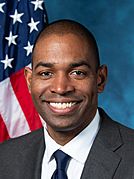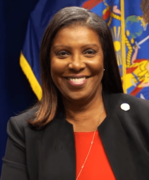Government of New York (state) facts for kids
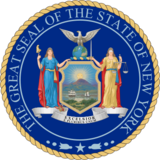
|
|
| Polity type | Presidential republic Federated state |
|---|---|
| Constitution | Constitution of New York |
| Legislative branch | |
| Name | New York State Legislature |
| Type | Bicameral |
| Meeting place | New York State Capitol |
| Upper house | |
| Name | Senate |
| Presiding officer | Antonio Delgado, President |
| Lower house | |
| Name | Assembly |
| Presiding officer | Carl Heastie, Speaker |
| Executive branch | |
| Head of State and Government | |
| Title | Governor |
| Currently | Kathy Hochul |
| Appointer | Election |
| Cabinet | |
| Name | Cabinet |
| Leader | Governor |
| Deputy leader | Lieutenant Governor |
| Headquarters | New York State Capitol |
| Judicial branch | |
| Name | New York State Unified Court System |
| Courts | Courts of New York |
| New York Court of Appeals | |
| Chief judge | Rowan Wilson |
| Seat | New York Court of Appeals Building, Albany |
The government of New York State is like the main team that runs things in New York. It's based in Albany, the state capital. Just like the United States government, New York's government has three main parts: the executive, legislative, and judicial branches.
The executive branch is led by the Governor. The legislative branch, which makes laws, is called the Legislature. It has two parts: the Senate and the Assembly. The judicial branch, which interprets laws, is called the Unified Court System. It includes the Court of Appeals and other courts.
New York is also divided into smaller areas like counties, cities, towns, and villages. Each of these has its own local government to help serve the people living there.
Contents
Executive Branch: Leading the State
The executive branch is responsible for carrying out the laws and managing the state's daily operations. The main elected leaders in this branch are:
-
Kathy Hochul (D)
Governor
The Governor is the head of the state government. The Lieutenant Governor is next in line and helps the Governor. The Attorney General is the state's chief legal officer. The Comptroller manages the state's money.
There are also many state departments that help the executive branch do its work. These departments handle different areas, like:
- Agriculture and Markets (food and farms)
- Corrections and Community Supervision (prisons and parole)
- Economic Development (jobs and businesses)
- Education Department (schools and learning)
- Environmental Conservation (protecting nature)
- Financial Services (banks and insurance)
- Health (public health)
- Labor (workers' rights)
- Motor Vehicles (driver's licenses and car registrations)
- Transportation (roads and bridges)
These departments create rules and guidelines to help carry out state laws.
Legislative Branch: Making Laws
The New York State Legislature is where state laws are made. It has two parts: the New York State Senate and the New York State Assembly. This two-part system is called "bicameral."
The Assembly has 150 members, and the Senate currently has 63 members. The leader of the Assembly is called the Speaker. The Lieutenant Governor is the President of the Senate, but another senator often leads the meetings.

The Legislature's main job is to create new laws. Once a bill (a proposed law) passes both the Senate and the Assembly, it goes to the Governor. The Governor can sign it into law or veto it (reject it). If the Governor vetoes a bill, the Legislature can still make it a law if a large majority (two-thirds) in both houses vote to override the veto.
The Legislature can also suggest changes to the New York Constitution. If they propose a change, the people of New York get to vote on it in a special election called a referendum.
Committees: Reviewing Bills
Both the Senate and the Assembly have many smaller groups called committees. These committees are important because they review bills related to specific topics, like education, health, or transportation. They decide which bills should be voted on by the full Senate or Assembly. This helps make sure that bills are carefully looked at before they become laws.
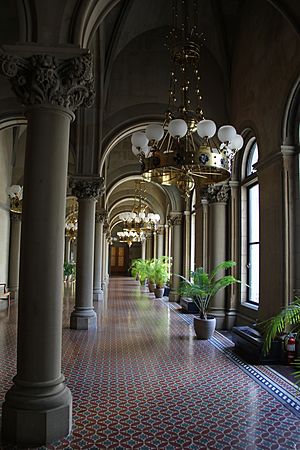
Legislative Session: When Laws Are Made
The Legislature meets for a "session" each year. This usually starts in January and continues until a state budget is agreed upon. During this time, members of both the Senate and Assembly work on introducing new bills, voting on them, and discussing changes to the Governor's proposed budget for the state.
Judicial Branch: Interpreting Laws
The New York State Unified Court System is responsible for explaining and applying the laws of New York. It makes sure that everyone gets equal justice under law and helps solve disagreements between people or groups.
The court system can seem a bit confusing because of its names. The highest court in New York is the Court of Appeals. This is where important legal decisions are made that affect the whole state.
There are also many other courts, including:
- The Supreme Court, which handles serious cases.
- Family Courts, which deal with issues related to families and children.
- Surrogate's Courts, which handle wills and estates.
- Local courts like the NYC Criminal Court and NYC Civil Court in New York City, and other city, town, and village courts across the state. These courts handle many everyday legal matters and are often where criminal cases begin.
The entire court system is managed by the Chief Judge of the Court of Appeals and other administrators.
Local Government: Serving Communities
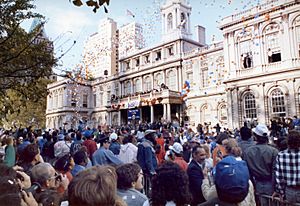
New York State is divided into many smaller areas, each with its own local government. These include 62 counties, and within those, 932 towns and 62 cities. There are also villages. These local governments provide most of the services you use every day, like schools, police, fire departments, and trash collection.
The type of local government (city, town, or village) depends on how the residents choose to organize it, not just its size. These local governments have special powers to make their own laws, as long as they follow the New York Constitution.
For example, when New York City became one big city in 1898, all the smaller town and county governments within it were combined into the single New York City government we know today, with its five boroughs.
Other Governments: Tribal Nations
In New York, there are also Native American tribal governments. These governments are largely independent from the state and local governments. This means New York State cannot interfere with how tribal nations govern themselves. However, the state can make rules about things that affect people who are not tribal members on tribal lands. For instance, the state can tax sales of certain items to non-tribal members on reservations.
See also
- Politics of New York (state)
- Elections in New York
- Law of New York
- New York State Common Retirement



